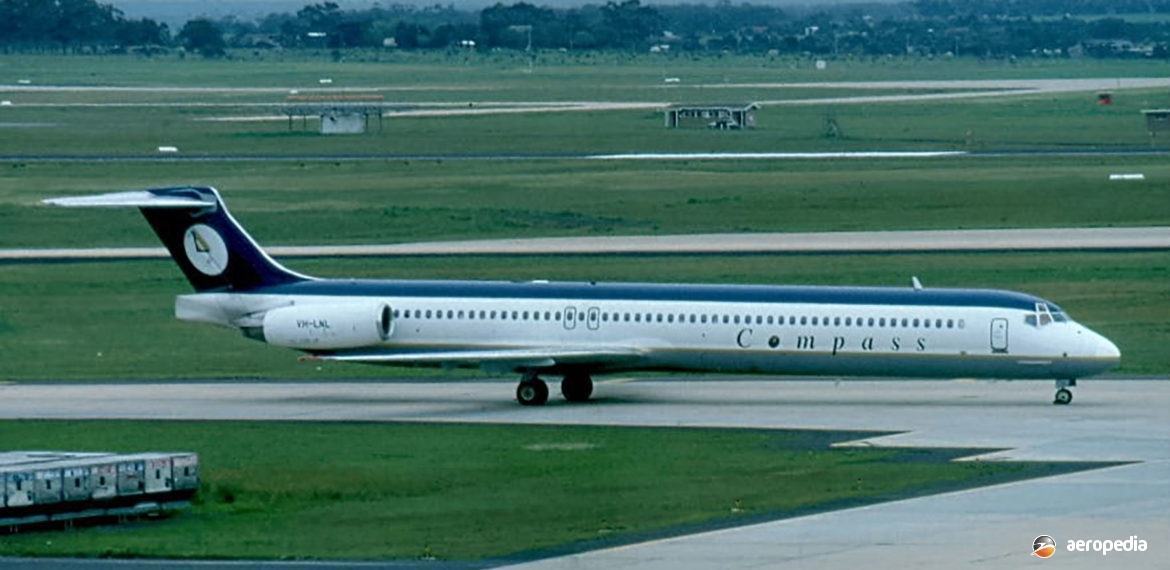Photograph:
McDonnell Douglas MD-83 VH-LNL (c/n 49437/1345) at Tullamarine, VIC in October 1992 (David C Eyre)
Country of origin:
United States of America
Description:
Short-medium-range commercial airliner
Power Plant:
Two 20,000 lbst Pratt & Whitney JT8D-217C turbofans
Specifications:
- Wingspan: 32.87 m (107 ft 10 in)
- Length: 45.06 m (147 ft 10 in)
- Height: 9.03 m (29 ft 8 in)
- Wing area: 118 m² (1,270 sq ft)
- Max cruising speed at 8,230 m (27,000 ft): 925 km/h (525 mph)
- Economical cruising speed at 10,060 m (33,000 ft): 840 km/h (522 mph)
- Range at 10,670 m (35,000 ft) at 813 km/h (505 mph) with 130 passengers and standard fuel: 4,395 km (2,731 miles)
- Empty weight: 33,183 kg (73,157 lb)
- Loaded weight: 67,900 kg (149,69 lb)
History:
The McDonnell Douglas MD-80 series, or Douglas DC-9 Super 80 Series as it was originally known, was the outcome of a continuous process of evolution and development from the basic and very successful DC-9 series, being basically a stretch of the DC-9 with new engines, designed to be more fuel efficient, and to meet future noise level requirements being introduced throughout the world. Engine chosen for the 80-series was the 18,500 lbst Pratt & Whitney JT8D-209 turbofan, this model becoming known as the Series 81, the maximum of passengers in a commuter bus layout being 172.
A large number of configurations was considered, as was a variety of engines, including the CFM-56 and JT-109D. In the event the fuselage of the DC-9-50 was stretched with a 3.86 m (12 ft 8 in) plug ahead of the wing, and a 48 cm (19 in) plug behind the wing. Initial orders were received from Swissair, Austrian Airlines, and Southern Airways. As initially launched, the Series 80 was 13.2 m (43 ft 6 in) longer than the old Series 10, and the wing was 28% larger than the Series 50. Fuel capacity was 21,874 litres (4,812 Imp gals). Subsequently the JY8D-217 engine rated at 20,000 lbst was offered to allow an operating weight of 66,678 kg (147,000 lb), this model becoming known as the Series 82. An all-freight variant of the 82 could carry 20,956 kg (46,200 lb) of cargo a distance of 1,926 km (1,196 miles).
The first of the 80 Series flew at Long Beach, California on 18 October 1979, and later five variants were offered, the MD-81, MD-82, MD-83, MD-87 and MD-88, the MD-87 having a shorter fuselage, the others being dimensionally similar but with different engines, fuel options, avionics and weights. By late 1992 orders for the series had reached over 1,200 aircraft. Eventually, when McDonnell Douglas became part of the Boeing organisation, this series was re-developed with new engines as the Boeing 717.
In mid 1992 Compass Airlines, the second Australian airline with this name, the former having operated Airbus A300-600Rs prior to going into liquidation, commenced operations on the Australian eastern seaboard with two MD-83s: VH-LNH (c/n 49938/1785 – ex XA-RTK) registered from 30 July 1992 to 24 May 1993; and VH-LNI (c/n 53121/1971 – ex N9012, D-AGWE [ntu]) registered from 6 August 1992 to 23 December 1993; and three MD-82s: VH-LNJ (c/n 49383/1236 – ex LN-RLF) registered from 8 September 1992 and exported in 1993; VH-LNK (c/n 49423/1283 – ex LN-RLG) registered on 28 August 1992 and exported to Norway as LN-RLG on 11 May 1993; and VH-LNL (c/n 49437/1345 – ex LN-RLR) registered to 19 August 1992 and exported in 1993.
These aircraft all arrived in Brisbane, QLD during August 1992, were registered to Southern Cross Airlines, and were leased to Compass (Compass Mk II as it was known). Two further aircraft were expected to be obtained in 1993, to become VH-LNM and VH-LNN, but in February that year Compass ceased operations and went into liquidation, the aircraft all leaving Australia and returning overseas to the leasing companies. Whilst in Australia they were mainly used on east-coast routes between capital cities.
In 2008 a company in Queensland known as Resource Exploration and Mining Co imported two McDonnell Douglas MD-82s for the transport of its personnel. These aircraft VP-CBH and VP-CBI, painted in the markings of Mineralogy, took up residence at Coolangatta Airport, QLD. After some service in Australia the aircraft were placed in storage at Coolangatta Airport, later being moved to Brisbane’s Eagle Farm Airport where they were still in storage in late 2019. They have never been placed on the Australian Register and their future is unknown.

